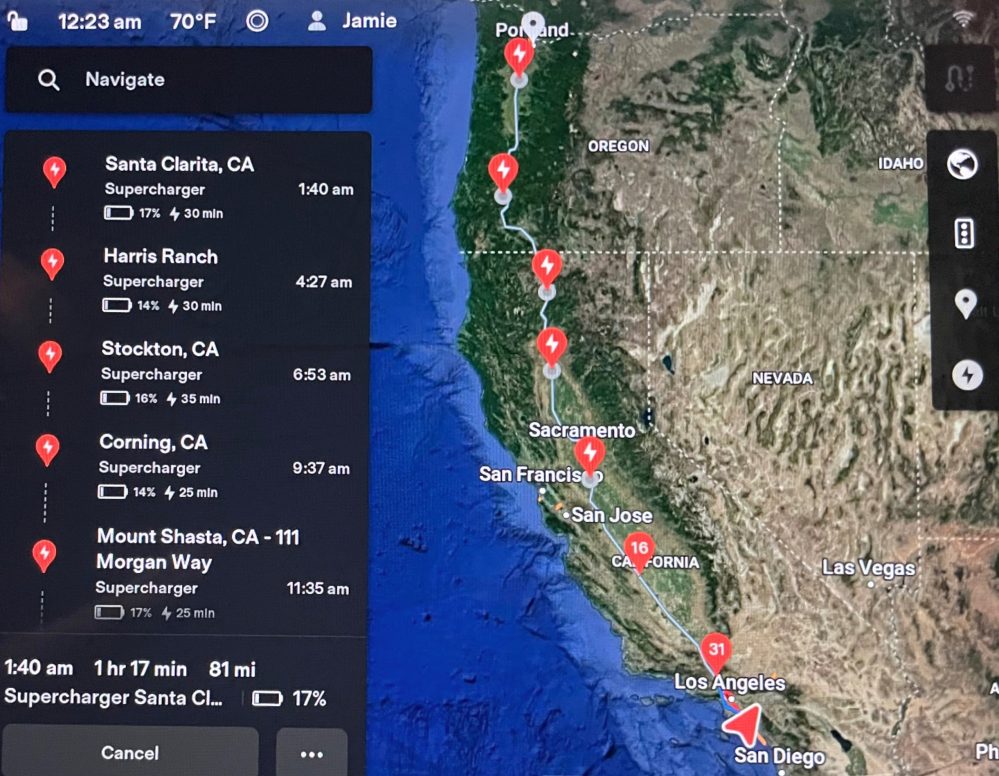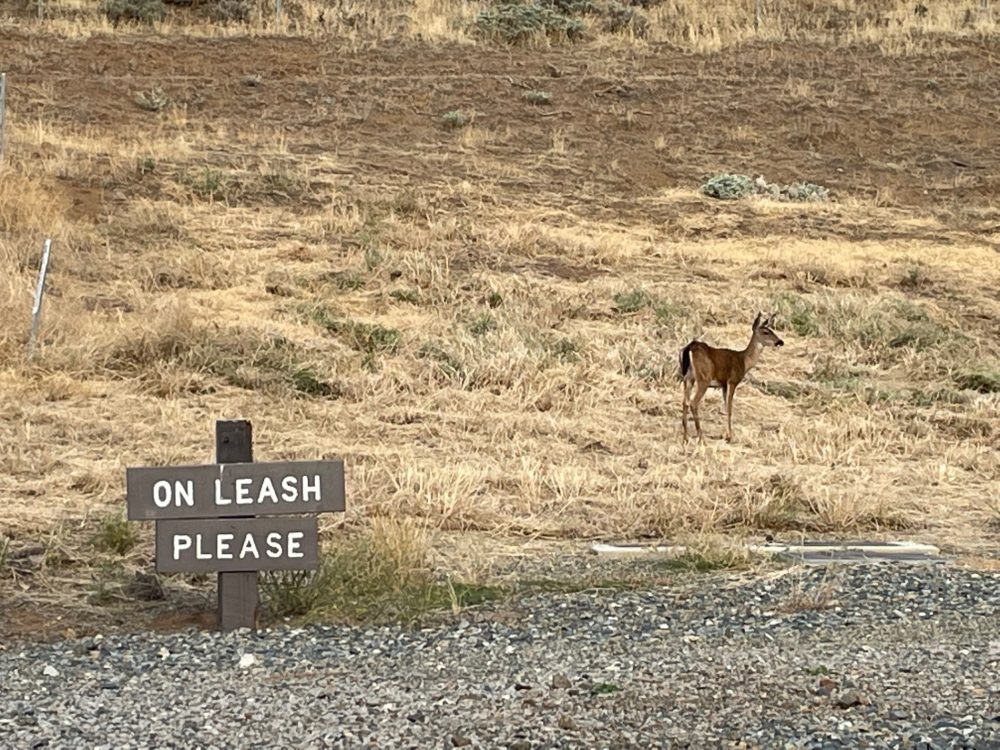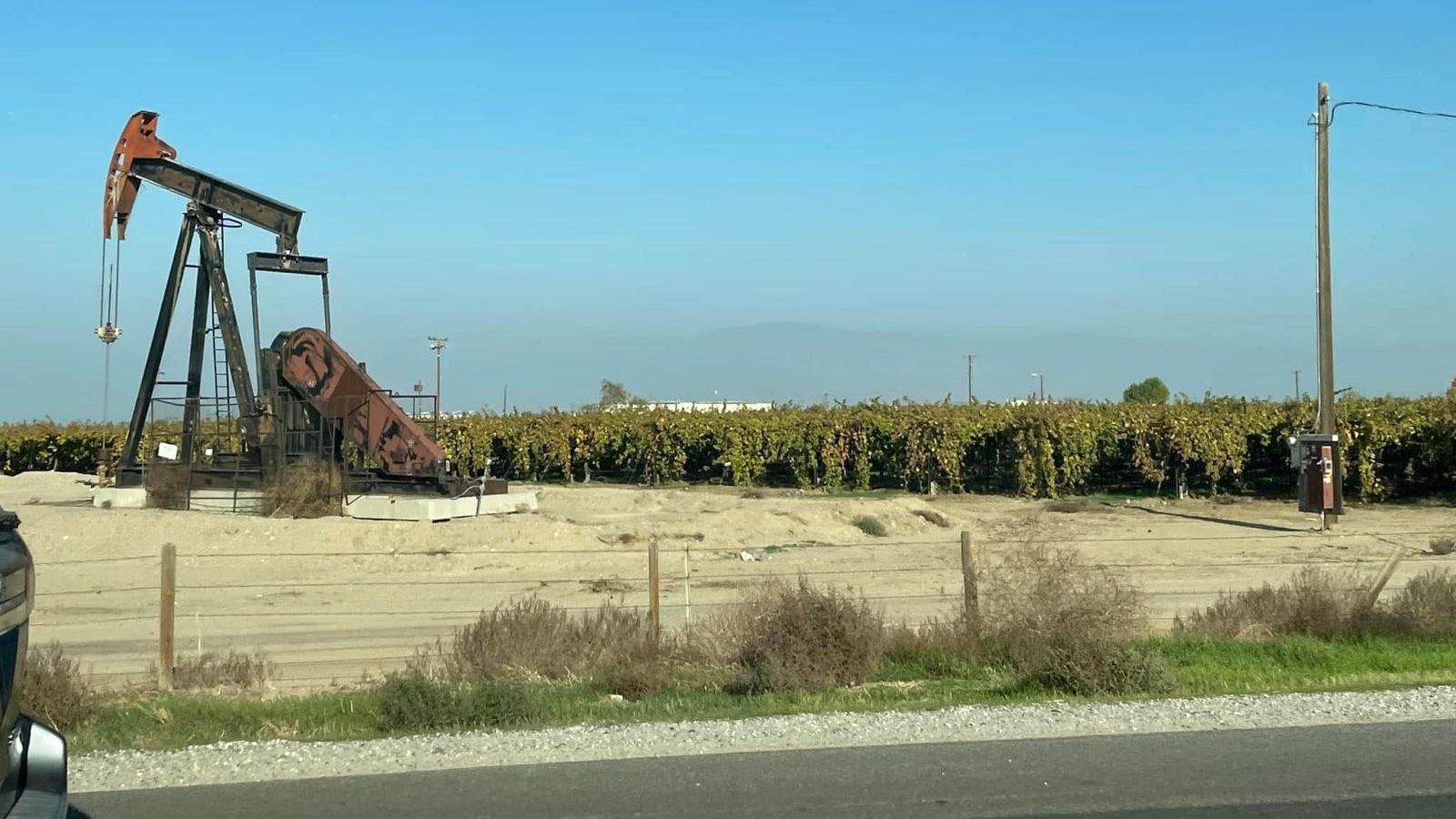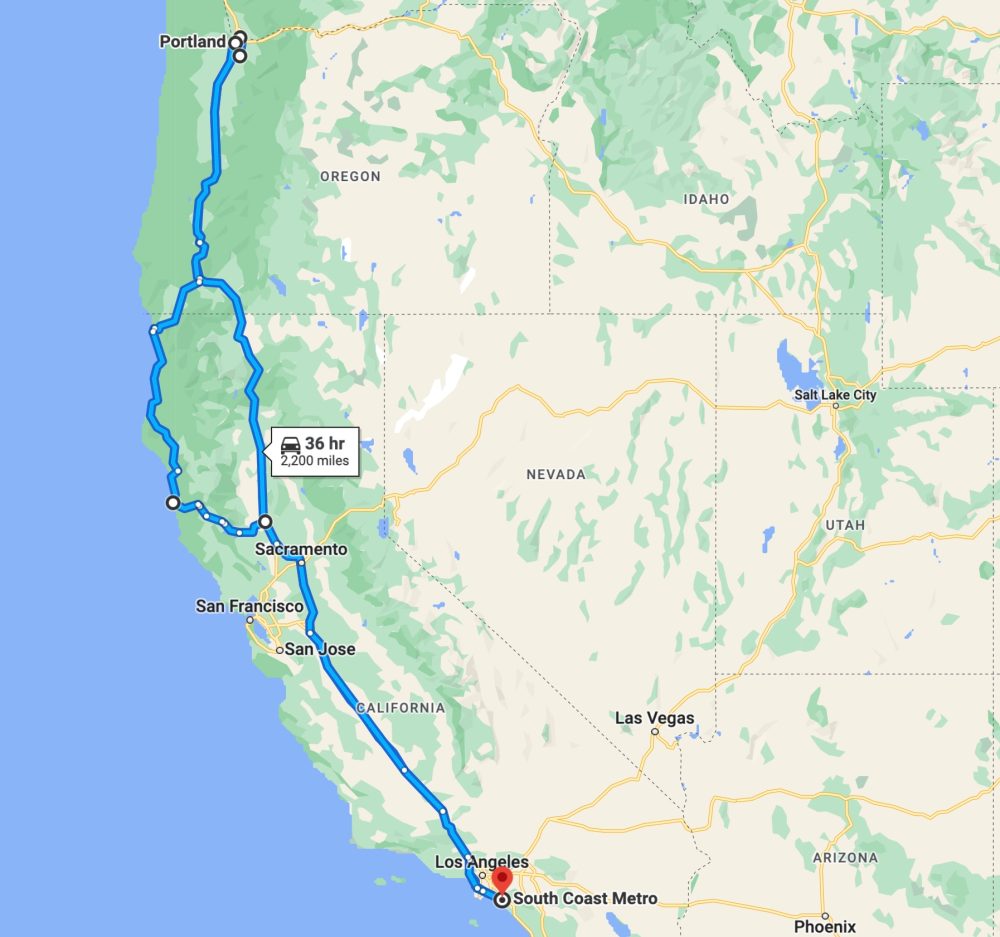
Recently I drove a Tesla Model 3 on an electric roadtrip from Southern California to Portland and back. The total distance was around 2,200 miles, with the bulk of the driving happening over the course of 5 days (3 up, 2 down), and I only “waited” for charging for about 25 minutes total over the whole trip.
There are many travelogues and youtube channels that go into deep analyses of efficiency and charging speed, with lots of detail on how exactly to plan an electric roadtrip. Though I typically do enjoy those sorts of details, I didn’t actually think to keep track of any of them during this trip, since they’re all sort of unnecessary at this point, because electric roadtrips are easy.
The roadtrip included a mixture of heavy driving days on interstates and lighter days on state routes with side routes and sightseeing. We had two drivers in the car, along with luggage for three, and didn’t bother to plan the route ahead of time, except for the goal of getting a little time on the Northern California/Oregon coast and seeing some coastal redwoods along the way. Both of us have plenty of experience driving and charging electric cars, though this is the longest electric roadtrip I personally have been on.
And that 25 minute number – that counts the amount of time spent waiting for charging and doing nothing else productive. If we were getting a meal, that was “free” charging time, since we need to eat anyway. In other words, time spent charging that would have otherwise been spent driving if we weren’t charging.
Side routes? Detours? No problem
It has been said many times that electric roadtrips are doable, as long as you stick to the plan and don’t deviate at all. Most chargers are along main routes which see the most traffic – smaller routes have fewer chargers, or slower ones, or don’t have any at all.
Well… we didn’t have a plan. We didn’t plan our route ahead around charger availability, merely left in the morning and charged where we wanted to, once we got hungry or needed to take a driving break. In the car’s navigation system, it’s easy to pull up a list of chargers, see what services exist at each stop, and search the map nearby for restaurants, hotels, bathrooms, and so on. And if you’re new to this whole thing, you can ask the car to route you to your destination and it will tell you where to charge and for how long (you can modify the plan, if you’d like, and we usually did).


Everything was straightforward until the second morning of the trip, where right before setting out towards the coast from Williams, CA, I sustained an injury which needed urgent care (I won’t bore you with the details of how badly my insurance company, Oscar, dealt with the situation, but they deserve mention for being unhelpful). Turns out there’s no urgent care in Williams, CA, so off we went on twisty roads towards the coast. After a couple hours through mountains and trees, we got to Fort Bragg, which along with urgent care facilities, also had a supercharger despite being quite far from anything that might be considered a main road.



We continued on and drove through the Avenue of the Giants, an area of coastal redwoods, the tallest trees in the world, which were breathtaking to behold and only made better by the silence of driving with electric propulsion. At one stop, a man in a truck remarked “you’re the first Tesla I’ve seen in four days,” presumably suggesting that Teslas mostly stick to the main roads and don’t get out to the more empty regions. We thought that was odd, since at no point on the trip did we feel restricted by charging concerns (and we did see other EVs – but maybe not as many as we saw on the main roads or near the cities).
Unfortunately we had to end our side-route adventure the next day, turning in through the mountains towards Grant’s Pass, due to the time loss associated with our medical adventure. The coastal route would have added about 2 hours (of driving, not charging), along with sightseeing time, and we had a dinner to get to – though charging in Bandon and Lincoln City on the coast would have been just about as easy as our charges in Grant’s Pass and Harrisburg were.
Charging is available, fast, and pleasant
Charging was never a problem during our electric roadtrip. We chose hotels with chargers (by checking PlugShare), but these hotels were in the towns we wanted to stop in, so we didn’t have to go out of our way to find these overnight charges.
Each overnight charge was “free,” insofar as it was included with the hotel, and it was nice to leave in the morning with a 100% charge (rather than ~80% which is the usual state of charge to leave a supercharger at). This provided more flexibility on where to charge during the day, and saved some money on supercharging fees.
Every charge save one or two was associated with a meal or bathroom break, which meant we spent little actual time charging during the trip. Every stop, by the time we were done with what we needed to do on the stop, the car was already ready to go with 200+ added miles of range.
Whether it be walking to and eating fast food, waiting to be seen at urgent care (whoops), devouring the haul from a local fruit stand, or having free wine samples (only the passenger of course), there was plenty to do at each stop and only ever a few minutes, if at all, spent “waiting” for the car to charge enough to continue on.



On that wine tasting point, a special mention goes to the Olsen Run Winery at the Harrisburg, OR supercharger, which exists poetically on the property of an old gas station (though for some reason isn’t listed in the in-car search for nearby restaurants – don’t be fooled, stop there anyway).
Instead of serving up stinky, cancer-causing dino juice, it now pushes electrons and delicious burgers (with veggie option), fries, shakes, and free wine tastings, and even serves as an event space (in… the middle of nowhere). It was such a pleasant stop that even though we didn’t need a charge, we stopped again on the way back South from Portland just for the burgers and conversation. We hope to see more entrepreneurial innovation with properties like this, converting stinky old gas stations into something much more pleasant.
And we didn’t even take advantage of every charge opportunity – one of which was actually easier for non-Teslas. We stopped at a rest stop right after the CA border just to look around, and by chance happened to find a free CCS/CHAdeMO DC fast charger there. We didn’t have the necessary CHAdeMO or CCS adapter, but didn’t need a charge anyway – though we still got an emotional charge, standing by a pleasant river, breathing clean air unsullied by gas station fumes, and seeing some unnervingly bold deer crawling all over the place on the rest stop lawn which was clearly marked “no pets.”



All told, we probably only spent a total of about 25 minutes across the whole trip doing nothing but charging. This was primarily at the last charge on the last day, where we stopped at an outlet mall (Tejon Ranch East supercharger) after business hours and spent about 15 minutes watching a couple play with their dog in the parking lot while charging. The point is: the amount of extra time spent actively charging across the whole trip was no more than the amount of active time it takes to fill up at gas stations – and, perhaps, even less.
650 miles in one day
Typically on roadtrips, I don’t like to do more than around 300 miles in a day. After that point you start feeling like you’ve been in the car forever, like you haven’t gotten to see or do anything outside of the car, you feel cooped up and tired and stressed and so on.
But, sometimes you just want to get home and rest your broken toe, and don’t have any particular sights you want to see along the boring I-5 in California. So, you spend the morning tooling around Mount Shasta after an overnight charge, then set out to drive almost the entire length of California in one day.
And when driving in a car with one driver with a broken toe and the other with a bum knee, autopilot is nice to have. While the promise of full self-driving is not here (…yet?), autopilot does work well on highways and helps reduce fatigue on a long drive like this.
On this 650 mile day, we stopped for three charges – Woodland to get a pizza, Firebaugh for a taco, and Tejon Ranch. Again, we didn’t have to wait for the car until the very last charge, where we weren’t hungry and didn’t need a break, so waited about 15 minutes.
Even if people recognize that electric roadtrips are doable, they will often carve out an exception for these long driving days, suggesting that they would be hindered by charging when they really need to make a lot of ground quickly. Well, given that we only “spent” 15 minutes charging during this 650 mile day (again, not counting the two fast food meals + bathroom breaks which we needed anyway), that doesn’t really sound like much of a hindrance given that at least one 10-minute gas stop would be necessary if the roadtrip were done on gas (and don’t forget the ~5-7 other gas stops that would have been needed over the 2,200-mile trip).
Reminders why electric roadtrips are important
We did make a brief stop during our longest driving day to look at Shasta Lake, which put a bit of a point on why we spent 5 days doing an electric roadtrip instead of the more convenient option of burning fuel in a plane to get to where we were going:
California, like many parts of the world, is experiencing historic drought. Shasta Lake, the largest reservoir in the state, is at critically low levels. The lake feeds the Bay Area and the Central Valley, the most agriculturally productive land in the nation which provides more than half of the fruits, vegetables and nuts for the entire US.
This drought is exacerbated by climate change, causing dry weather and high temperatures in the area. And climate change is caused by human greenhouse gas emissions. Fossil fuel emissions from transportation are the largest contributor to climate change in the US (another major factor is animal agriculture – which not only produces methane emissions but uses large amounts of water).
The rest of the final day was spent driving through that valley, which also happens to be one of the more polluted places in the country. Air pollution from trucks and machinery gets trapped by the mountains, causing constant smog conditions. Despite being in a valley, you wouldn’t really know it, because much of the time you can’t see the mountains all around you due to the smog.

So not only was an EV the right choice for the practical side of the roadtrip, but also for the greater picture – trying to avoid the environmental disasters caused by fossil fuel usage.
Your mileage may vary?
We encountered no charging reliability problems on the trip. There were a few supercharger connectors that weren’t working at some of the stops, but the car informed us ahead of time which ones were inactive and it never affected charge speed or the locations we chose to charge at.
Of course, this trip was on the West Coast of the US, mostly in California, the state with the most EVs. I have been assured that the trip would be more difficult elsewhere, or on a network other than Tesla’s superchargers (though, other cars will gain access to Tesla’s system soon™). Other networks probably wouldn’t be as easy, and other cars don’t have as elegant a routing and “nearby search” system as the Tesla system, or as simple of a “plug-and-charge” payment system like superchargers have.
But I have also been assured that this trip would be difficult, with so many people talking about how hard it is to take roadtrips in an electric car.
But it wasn’t hard, it was easy. So this suggests to me that those other trips, while perhaps not as easy as mine, may well be more possible than people think they are.

I will reiterate, again, that we did not plan a route ahead. We didn’t plug our trip into ABRP or other route planners. We didn’t stick to a specific speed so we could make our charging plan. We changed routes frequently by whim, we charged when or where we felt like doing so, or where there was a restaurant we were interested in. None of this was an issue. It was just a regular roadtrip, but less polluting, more pleasant, and cheaper.
And yet, there is a persistent myth that since EVs are supposedly incapable (they are not, as displayed above) of doing this one thing that most cars will never do, they are therefore not an acceptable source of transportation. Nevermind that they are superior in normal driving tasks – and, as displayed above, not even inferior in this one – somehow this myth still persists.
It should also be noted that trips like this are not a common occurrence. As a practical matter, most cars will rarely if ever do a roadtrip like this. But, particularly in America, cars are not sold for what they’ll be used for, but for every conceivable purpose the buyer could ever imagine using them for. You’re not being sold a tool, you’re being sold a dream – the dream of freedom, in the form of a $1,000/mo car payment.
This is the reason the “electric roadtrips are impossible!” myth has gained so much traction – Americans are buying the dream of the Great American Roadtrip, and think that an EV makes that dream impossible.
Well, I’m here to tell you that it’s not impossible. In fact, it’s more than possible – it’s even better than the alternative.
Add Electrek to your Google News feed.
google-news
Subscribe to Electrek on YouTube for exclusive videos and subscribe to the podcast.
Author: Jameson Dow
Source: Electrek



